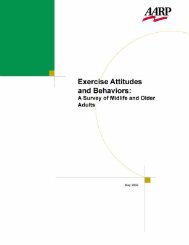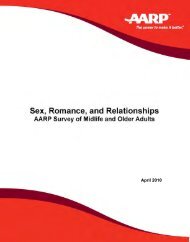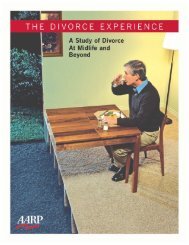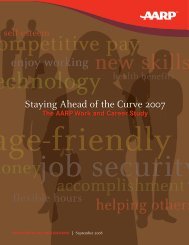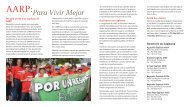The New Aging Enterprise - aarp
The New Aging Enterprise - aarp
The New Aging Enterprise - aarp
Create successful ePaper yourself
Turn your PDF publications into a flip-book with our unique Google optimized e-Paper software.
“Too Boutique.” True, the Center for Healthy <strong>Aging</strong> has not been replicated and<br />
naturally occurring retirement communities like Beacon Hill Village tend to flourish only in<br />
limited environments. However, Elderhostel has become the largest education-travel program in<br />
the world, Curves is one of the most successful franchises of all time, and the Vanguard family<br />
of funds is number two in size in the world. <strong>The</strong>se are hardly “boutique” programs.<br />
“Founder’s Syndrome.” Can <strong>New</strong> <strong>Aging</strong> <strong>Enterprise</strong>s outlive their founders? In some<br />
cases, the answer is clearly yes. Elderhostel survived the voluntary departure of founder Marty<br />
Knowlton, Vanguard continues to prosper without John Bogle at the helm, and Experience Corps<br />
was intentionally spun off after its creation by Marc Freedman. <strong>The</strong>se charismatic leaders<br />
stepped aside, and their legacies continue. Other founders are still intimately involved in<br />
leadership of their organizations: John Erickson, Bill Thomas at Eden, Tim Driver at<br />
RetirementJobs, and Gary Heaven at Curves. <strong>The</strong> jury is still out on whether these <strong>New</strong> <strong>Aging</strong><br />
<strong>Enterprise</strong>s will survive or whether they will be victims of “founder’s syndrome.”<br />
“Just the Private Sector.” <strong>The</strong> aging of Boomers has unleashed a torrent of<br />
publications promising guidance on “turning silver into gold” 116 and marketing to older people.<br />
Isn’t the <strong>New</strong> <strong>Aging</strong> <strong>Enterprise</strong> just one more contribution to merchandising later life? This<br />
critical point raises a question: Must the success stories profiled here remain in the private sector<br />
alone, whether profit or nonprofit? Alternatively, how can the lessons of <strong>New</strong> <strong>Aging</strong> <strong>Enterprise</strong>s<br />
be incorporated into public policy aimed on senior housing, health promotion, long-term care,<br />
saving for retirement, and all the rest?<br />
<strong>The</strong> argument advanced here is that we should not turn over these tasks to “privatization”<br />
but instead should learn from, and apply, lessons exemplified by <strong>New</strong> <strong>Aging</strong> <strong>Enterprise</strong>s. Just as<br />
Federal Express offers lessons for the public postal system, or private universities have lessons<br />
for public ones, so <strong>New</strong> <strong>Aging</strong> <strong>Enterprise</strong>s can be a seedbed for new policies that help public<br />
institutions respond imaginatively to population aging, just as the Swedish welfare state has done<br />
with its new pension system. Public versus private is a false choice here. <strong>The</strong>re is no reason<br />
why public policy in the USA could not adopt features of the Swedish approach, if the political<br />
will is there. Similarly, there is no reason why lessons from Elderhostel for late-life learning or<br />
from Curves for exercise and weight loss could not be adopted by public policy. Private<br />
initiative, whether in business or volunteer form, can show the way. Public policy demands a<br />
political response to these opportunities.<br />
It is not impossible to imagine a world where community colleges make low-cost, latelife<br />
learning more widely available, where the public aging network is a leader in health<br />
promotion, and where government funding supports humane choices in long-term care. <strong>The</strong>re<br />
are steps already underway in these directions. In short, public versus private here is a false<br />
choice. What we face is the challenge of making all organizations more efficient, effective, and<br />
sustainable, as the <strong>New</strong> <strong>Aging</strong> <strong>Enterprise</strong>s have demonstrated. <strong>The</strong> choice is ours.<br />
40



